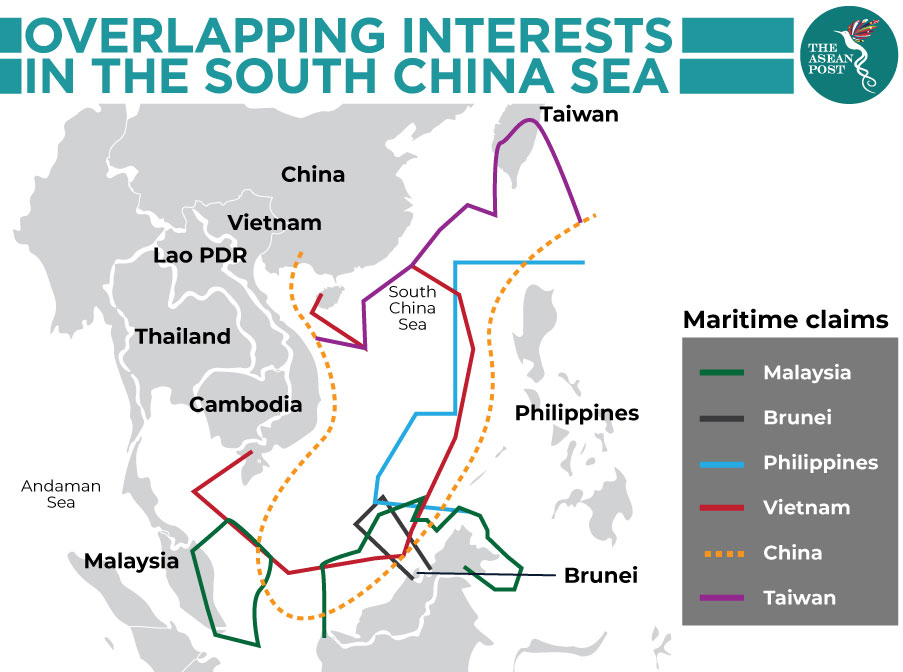ASEAN Outlook To Solve South China Sea Dispute?

This year marks one of the most important years for ASEAN’s geopolitical landscape. During the plenary session of the 34th ASEAN Summit in June, all member states agreed to adopt the ASEAN Outlook on the Indo-Pacific. The brief five-page document emphasised the ASEAN led mechanism in dealing with strategic issues in the Indo-Pacific region. It could not be denied that one of the most important ongoing issues in the region is still the South China Sea dispute, so will the Outlook help to solve the ongoing dispute?
Initially, the Outlook aims to rebalance the outgrowing interest between major powers in the region. As one of the most dynamic regions in the world, ASEAN has often been a battleground of competing ideas between major powers. The United States (US) Free and Open Indo-Pacific Strategy is faced-off with the Chinese Belt and Road initiative. Then, there are also other proposals from India, Japan and Australia.
There are at least two reasons this article argues that the ASEAN Outlook on the Indo-Pacific might help the region in navigating and maintaining the peaceful South China Sea. First, the document may strengthen the ties between Southeast Asian countries. Instead of picking a side in the growing influence in the dispute the document may unify the common perspective of all Southeast Asian countries regarding the rivalry of power.
The current practice shows that the Southeast Asian countries don’t have the same political views on whether to be more US or China driven, the political considerations are more fluid and led by each national interest. Some are more Washington-oriented and others more Beijing. Although the US is not a claimant in the dispute, their strong interest in navigation will lead their presence in the region.
Currently there are two main conflicting interests between the US and China in the South China Sea. China - as the major claimant of the whole South China Sea - is claiming all the islands and maritime features including the so-called “Nine-dash line.” Therefore, China seeks to protect their claimed islands. This includes putting a maritime militia and constructing some of the artificial islands.
On the other hand, the US, as a non-claimant and a non-party to the United Nations Convention on the Law of the Sea are interested in assuring the freedom of navigation in the region, especially the South China Sea. Through their Freedom of Navigation Program, the US are often sending their warships as assertions of the program.

Therefore, instead of picking a side between two major powers, the Outlook might strengthen the region with their own version on how Southeast Asia should engage with the Indo-Pacific region.
Secondly, the Outlook can set the rules of the game. Although the Outlook is not meant to create new institutions or mechanisms other than the existing ASEAN norms and principles, the document is significant due to the fact that they reiterate the regional commitment in respecting the rule of international law in the region, especially the United Nations Convention on the Law of the Sea.
Indeed, for the last several decades, since the South China Sea dispute arose, many countries see the dispute as the major threat for the region. The conflict might lead to any unpredictable direction. Therefore, the need for respecting rules of international law is becoming more and more important.
Indeed, if we take a closer look at the document, we surely can see how the Outlook is very much driven by ocean geopolitical affairs. It can be seen by the first area of cooperation, which is the maritime cooperation. The document recognises that the maritime issues such as unresolved maritime disputes have the potential for open conflict. Therefore, cooperation for a peaceful settlement of disputes is very crucial.
Moreover, the document also emphasises promoting maritime safety and security, and freedom of navigation and over flight; addressing transnational crimes, including trafficking in persons or of illicit drugs, sea piracy, robbery and armed robbery against ships at sea.
With this Outlook, all the ASEAN states have agreed to have at least common views on maintaining the peace and security in the region. In general, the ASEAN Outlook on the Indo-Pacific aims to bring the successful ASEAN story in maintain the peaceful in the Asia Pacific region but broader to the Indian Ocean. With all the “ASEAN way” principles, many consider ASEAN as one of the most successful regional blocs in maintaining peace and avoiding conflicts in the region.
Therefore, the Outlook seems to want to bring the successful ASEAN story to the maritime domain, including the ongoing South China Sea dispute.



No comments:
Post a Comment